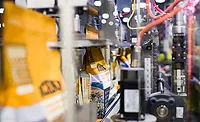Editor's Note
What food processors can learn from other industries

Sometimes a question is an answer.
At PACK EXPO in October, I was meeting with the CEO of a large packaging technology company. As we talked about the changes the food industry is facing and how all of the different elements of production are adapting, I asked him this question:
“Are food manufacturers starting to think of what they do as manufacturing?”
He paused for a moment, then responded, “I can’t believe I’ve never thought of it that way before.”
What happened next was fascinating. With that framing in mind, he started to think out loud about all the things that food manufacturing has in common with other forms of manufacturing. While there are obvious differences when it comes to making food as opposed to auto parts, once the food is made and ready to be packaged and shipped, those differences start to disappear. There’s no reason you can’t use the same basic principles for moving a box of finished pasta to its final destination as you can use for spark plugs.
I’ve seen this pop up here and there in other conversations recently, which is why I had it in mind when I asked the question. In a lot of ways, the food manufacturing industry is adapting concepts and practices from other areas of manufacturing, and the reasons for doing so are simple: Efficiency and cost-cutting.
In our industry, we still have to keep things such as sanitation and food safety in mind; nobody ever recalls serpentine belts because they contain undeclared allergens. But the processes are in many ways transferrable, which is why we’re seeing more food manufacturers looking for people with skills such as lean manufacturing. It’s why we see processors who can do so looking at concepts such as just-in-time delivery (or something close to it) or high-speed packaging or conveying.
And it’s definitely showing up in the realm of automation. Automation isn’t new to the food industry, but it’s being pushed further and further every day. A lot of the companies I visited at PACK EXPO were showcasing some kind of automation solution that is offering processors the ability to do things they wouldn’t have dreamed of five or 10 years ago, but that other industries may have been doing for a long time.
Whether it’s robots that can be programmed with the push of a couple buttons, conveyors that can move product at higher speeds, or variable-speed motors that continue to offer more and better options for running at less than high capacity, equipment manufacturers are offering food processors capabilities that never existed before.
The challenge, of course, is successfully implementing these capabilities. As I said earlier, safety concerns are a challenge that many kinds of manufacturing don’t have to deal with, while the food industry has to continually keep them in mind. But if you can successfully balance safety standards, regulatory requirements and speed, then what you can do in your plant will be limited only by your imagination.
Looking for a reprint of this article?
From high-res PDFs to custom plaques, order your copy today!






